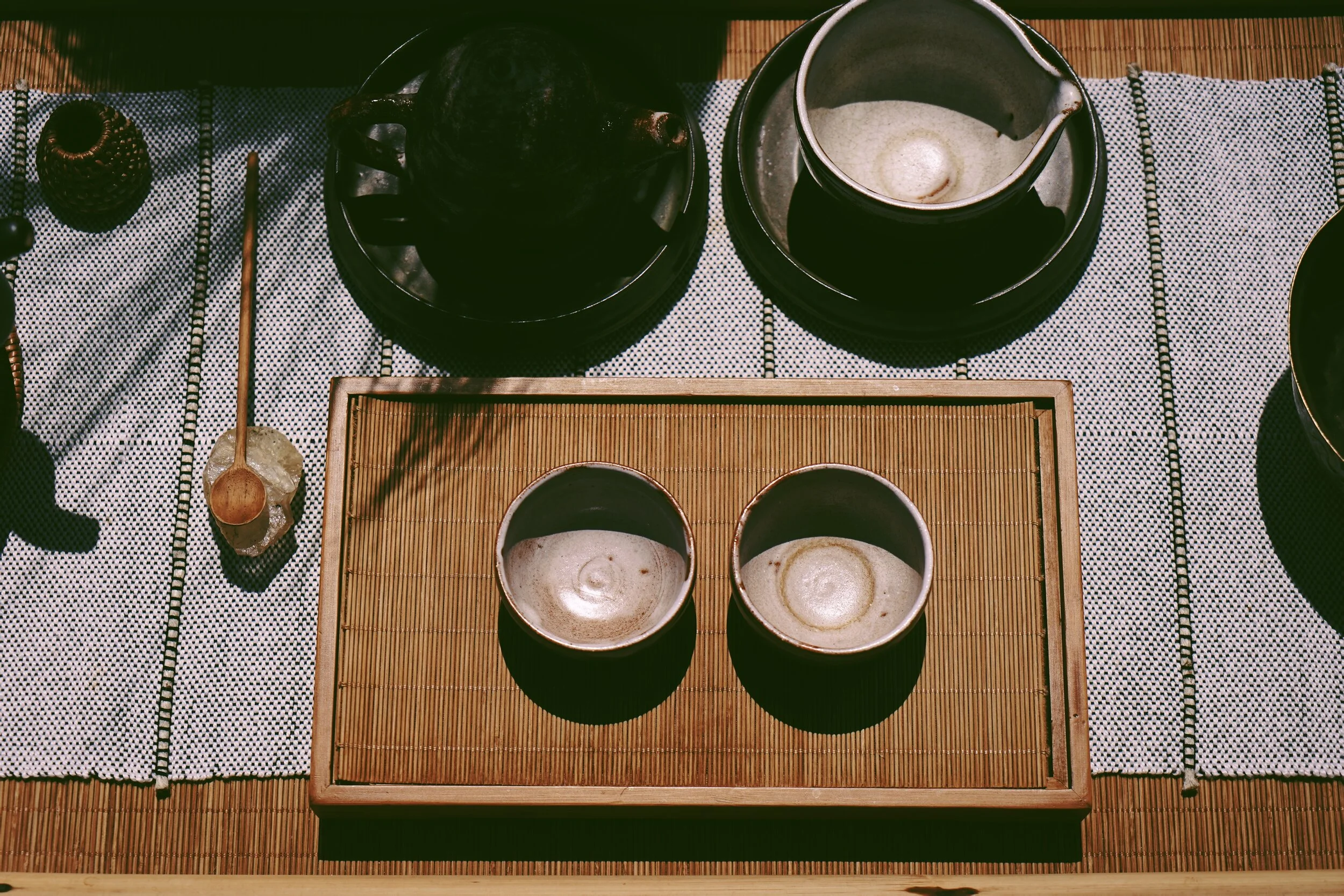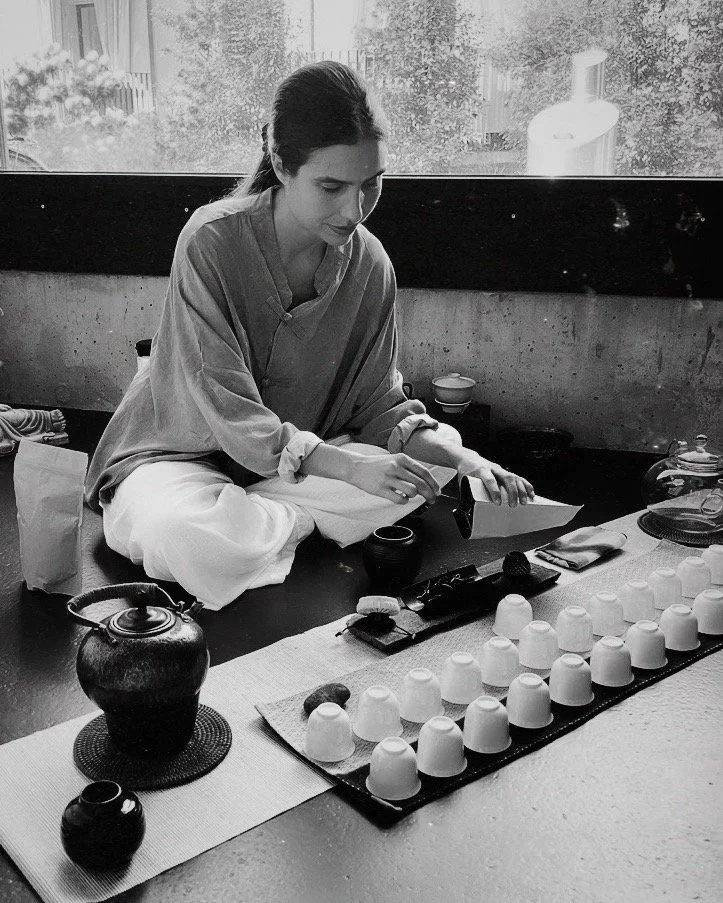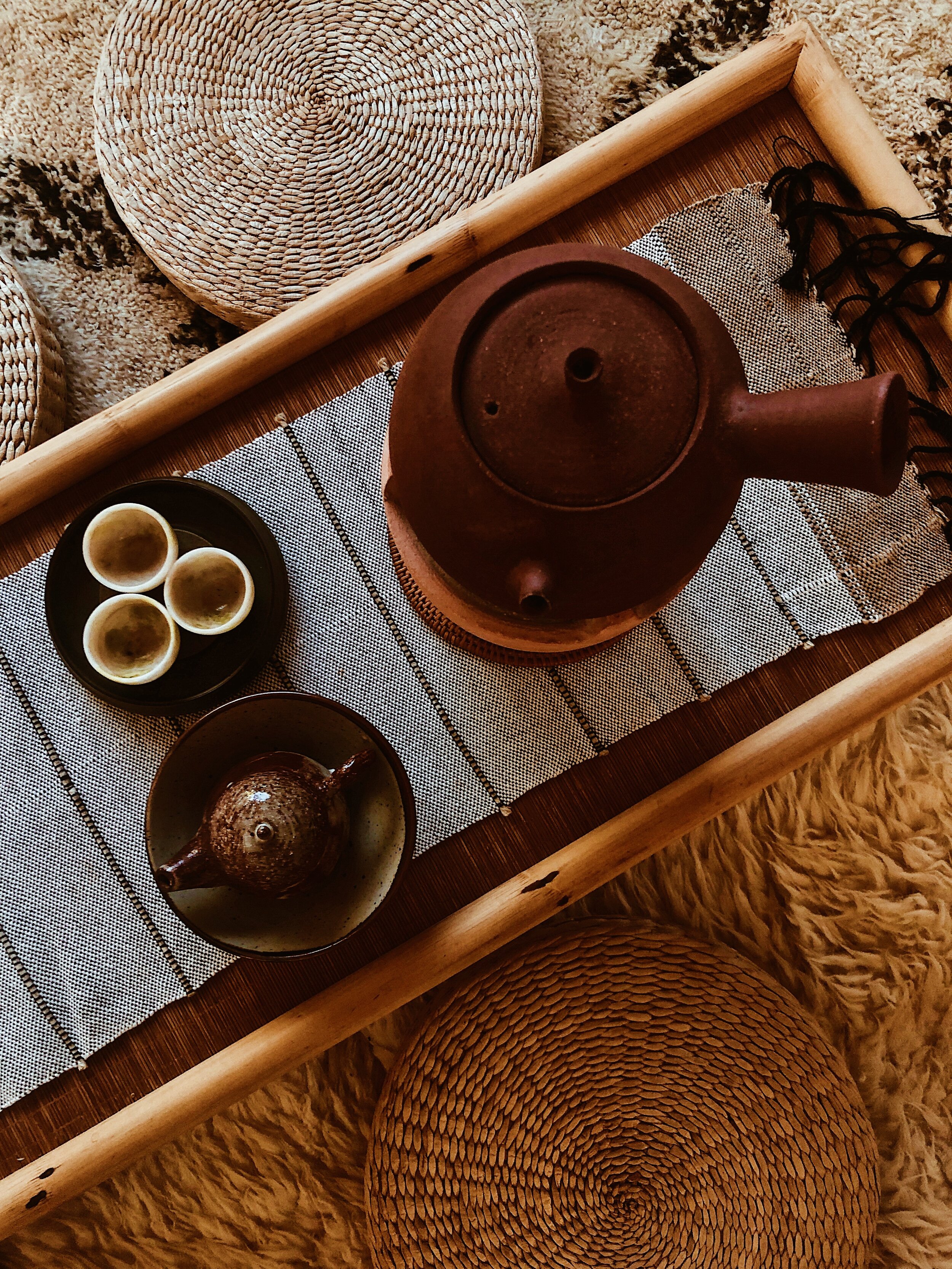
How to explore Chapter 4
In this chapter, we will be exploring the Chinese tea ritual of Gong fu cha, and its way as a neigong practice.
You may want to start this chapter by exploring the audio theory, supported by he written theory. Below, in the written theory, you will find two other videos : 1 video presenting and demonstrating the vessels tools for Gong fu cha + 1 video demonstrating the different ways to pour your water. Finally you will find 2 videos demonstrating the flow for the ritual of Gong fu cha.
Gong Fu Cha Theory
The practice of Gongfu cha originated in the South East of China, in Guangdong and Fujian province, more precisely in Chaozhou, around the Ming Dynasty. Some would say that the very first to have practiced Gongfu tea were the Teochew people, from Chaozhou.
Gongfu tea was born during a time where the technology to produce tea evolved and many new types of tea were discovered. Tea was no longer only served in powder form. Whole leaves would be steeped in water in vessels, and the infusion of water and leaves would give birth to tea.
The definition of “Gong Fu” is “making something with skills”. Therefore, “Gongfu cha” is “making tea with skills”.
The practice of Gongfu cha is the art of making tea in China, Taiwan, Malaysia and beyond. To make anything with skills, it requires cultivating presence. Gongfu cha is the cultivation of discipline and dedication: to your breath, to your presence, and to the dance of water and leaves.
In Gongfu cha, every gesture, every tool, every movement, is designed to celebrate the flavors, aromas, and full experience of the tea. The intention of the journey is to access the full potential of the tea and become aware of the “Cha Qi”, the energy of tea.
This practice and way of preparing tea involve creating a succession of short infusions, like a journey, where the leaves and buds of Camellia Sinensis are revealing the story, flavors, aromas and wisdom to the water and to you, slowly and progressively, from cup to cup.
The idea is to explore the connection between the water and the leaves-buds, to find the right alignment of temperature and duration of steeping, so discover the full potential, in each cup of tea.
The flow and steps of this ritual is a reminder of the importance of slowing down, to counterbalance the rapid pace of modernity.
To practice Gongfu cha is to practice Wei Wu Wei, the action of none-action. It is the art of practicing, until we start embodying the practice in our daily life. It is said that we understand the essence of a practice after repeating 300 times, and we embody the practice after repeating 3000 times.
Every moment in life is an occasion to practice. We tend to get distracted. When we return to Gongfu cha, we practice how to return to presence, so we can make tea skillfully and access the full potential of the tea.
Gongfu cha is considered a form of Neigong practice, as it is a daoist discipline sharing a similar intention with Qigong, Tai Chi, Daoist Yoga, meditation or breathing techniques.
Gongfu cha was influenced by Daoism and Chinese martial arts.
Gongfu cha can be considered a form of soft internal martial art, or Neija : the internal art of cultivating the skills of presence and breath, so we can pour our presence into the dance of water and leaves, and offer the full presence of tea into cups to our guests.
Gongfu cha is the most traditional way to serve tea in China, Taiwan and Malaysia, since the Ming dynasty. There are many forms of Gongfu cha, depending on the country, region and type of tea being served.
Intuitively Connecting to Water
THE TEMPERATURE OF WATER FOR YOUR RITUAL
Typically, every type of tea will have its way to connect to water.
In general, lighter tea (green, white, yellow, or light oolong tea) prefers water between 160F to 176F (70C to 80C), and darker tea (darker oolong, red, hei cha) prefers water between 176F to 200F (80C to 95C). We try not to boil our water above 200F, since water loses its oxygen when reaching complete boiling point. We recommend not to use any thermometer and to practice connecting to your water intuitively, by listening to the sound or observing the size of the bubbles forming at the surface. Warming your water is a meditation by itself.
Crab eye bubbles : This is when small bubbles are just starting to form at the surface of the water warming up. This water temperature is ideal for lighter tea (green, white, yellow, or light oolong). When you see crab eye bubbles forming at the surface of your water, try to listen to the sound, to get familiar with it. Use all of your senses to get to know your water temperature.
Fish eye bubbles : This is when larger bubbles are forming at the surface of the water getting warmer, just before it reaches complete boiling point. This water temperature is ideal for darker tea (darker oolong, red or hei cha). When you see fish eye bubbles forming at the surface of your water, try to listen to the sound, to get familiar with it. Use all of your senses to get to know your water temperature.
Tools for Gongfu Cha
Chaxi (TEA PLAY/TEA STAGE)
Chaxi could be translated by “tea play” or “tea stage”.
It is your tea mandala, an expression of the harmonious way of nature, shared through your creative way of decorating your tea space, your “tea stage”.
Choose a theme inspiring you in the moment of your ritual, and follow this theme to create your chaxi. Every new moment for tea is an occasion to create a new chaxi. You can find your inspiration within the season of nature, or simply let your imagination guide you, depending on with whom you will be sharing tea or if it is for self practice. Your chaxi will consist of a chabu (tea runner) or a tea tray, maybe a tea stone or a piece of wood to elevate your vessels. You can also add flowers or any piece of nature that you wish to incorporate into your ritual.
Kettle
Made of earth or iron, to warm your water. We recommend to warm your water on charcoal for outdoor tea, or on a stove for indoor tea.
Primary vessel
Your steeping vessel, where the dried leaves and buds will be connecting with the water, to give birth to tea. Your primary vessel can either be a Gaiwan (made of clay, porcelain or glass), a Yixing teapot (made of zisha clay from China), a Jianshui Zitao clay teapot (from Yunnan) or any small clay or porcelain teapot (Cha Hu) with a volume of not more than 150ml.
Secondary vessel
Either called a Gong Dao Bei (fairness cup) or Cha Hai (serving pot). It can be made of clay, porcelain or glass. The infusion of water and leaves is poured from the primary vessel into this secondary vessel, allowing the infusion to be equally distributed between the guests. It is also practical if you are doing self practice, to serve the infusion into your cup. This vessel isn’t used in every Gongfu cha tradition. There are many forms of Gongfu cha, depending on the region. Some are using the Cha Hai or Gong Dao Bei, others are not. In the “Chaozhou” tradition, there is no secondary vessel.
Small tea cups
In gongfu cha, we serve tea in very small tea cups, of a volume of not more than 50ml. Since the intention is creating a succession of infusions, we traditionally explore the journey through small quantities of tea at a time, to allow the leaves to progressively reveal the story.
Rinse water container / Jian Shuĭ
Jian Shuĭ is for “Water container”. Usually this vessel will be a bowl, either made of clay, metal, porcelain or glass, in which you transfer the water used to rinse your vessels and your tea leaves.
cha chuan
Your “tea boat” or tea plate in which your vessels are sitting in. The cha chuan is collecting the water that may be overflowing. It is serving the same purpose as the tray table.
Chadao
Set of bamboo utensils for Gongfu cha (tongs, scoop, funnel, spoon, spout needle and holder)
Optional accessories
Bamboo or rattan coasters for your cups, tea cloth, strainer, tea pet or tea stone, incense.
The different movements of Water
In this ritual, not only we honor the leaves and buds, but we also honor Water. Remember that Water is the Mother of tea.
Since most of our water comes from a tap, it has lost its connection with the way it moves naturally in nature. Tap water doesn’t remember the way of the river, the spring, the stream, the lake or the ocean. Through the way of chadao, our intention is to mindfully recreate the different natural movements of water in our ritual, the same way that it moves in Nature…
Long Flowing Water
-
Snow melt or glacier water, traveling kilometers from the top of a mountain across forests, villages. The long journey of the long flower water gives this type of water a lot of oxygen and a strong Qi, reminding of the elemental wisdom of Wood. We typically pour the long flowing water at the beginning of our ritual, from the kettle to the primary (steeping) vessel. This movement is an invitation to take a deep breath in, to open the body, to create space to welcome presence, for the ritual of tea.
Slow Flowing Water
-
Gentle water, moving from stream to stream, inviting a calm and clear mind. It is subtle and gracious, reminding of the elemental wisdom of Water. We typically can pour the slow flowing water at any time, when pouring the infusion from the primary vessel into the secondary vessel or into the cups. It is an invitation to return to a calm presence.
Swirling Water
-
Balanced water, at a river bend, in circular motion. It is carrying harmonious energy, reminding of the elemental wisdom of Earth. We typically can pour the swirling water, from the exterior to the center, at any time, when pouring from the primary vessel into the secondary vessel or when pouring into the cups. It is an invitation to remember balance and harmony.
Torrential Water
-
Strong water, falling at a fast speed, either from torrential rain, powerful waterfalls or strong river. It is carrying a strong Qi, awakening focus and attention, reminding of the elemental wisdom of Fire. We typically pour the torrential water at very rare occasions during the ritual, maybe when rinsing the vessels at the beginning, to awaken the attention and focus. It is an invitation to remember to be letting the heart guide us through the ritual.
Steam Water
-
Volatile water, like the water of clouds or the fog sticking to the mountains. It is the steam created by tea, sticking to the interior of the lid of the primary vessel. It is not very visible, but can be felt through the sense of smell. When doing your rinse at the beginning, take a moment to connect to the steam of tea awakening in the vessel, by removing the lid after the rinse and taking a deep breath into the interior of the lid to connect to the aromas. The steam water carrying aromas in the lid is a reminder of the elemental wisdom of Metal, the infinite mystery of life.

Tea Exploration : Gong Fu Cha
I invite you to explore the flow of the ritual of Gong Fu Cha with me. If you do have traditional Gong Fu Cha vessels, feel free to use them. Otherwise, you can use a simple bowl to infuse your leaves, and another bowl to transfer your infusion and receive your tea. You may want to use a strainer on top of the bowl in which you will be receiving the tea, when transferring the infusion from one bowl to the other, to strain the leaves or buds.
FLOW FOR GONG FU CHA
Start by rinsing your vessels, and discard the water into your rinse container
Add your leaves to your primary vessel (either teapot or gaiwan)
If you are exploring oxidized or aged tea, quickly rinse the leaves by adding water and quickly discarding the water into your rinse container
To create your first infusion, add water into your primary vessel and steep for the appropriate amount of seconds (it varies depending on the tea that you are exploring)
Serve either into your Cha Hai (serving pot) or directly into your cups
Return to the same flow, to explore the dance of water and leaves, cultivating dedication for. your breath and presence
FINGER TAPPING
In the ritual of Gongfu cha, it is a tradition to tap with two fingers two times next to the cup before receiving it, as a way to silently pay respect and show gratitude to the tea, and to the person serving the tea. Everyone have their own opinion or story to share where this tradition came from or what it means. Some believe that it is to represent the act of kneeing in gratitude, and I have also heard the story that it is to honor the dao (the two tapping symbolizing what exist below and above).
RECOMMENDATIONS
If you are exploring white, yellow or green leaves from China, we recommend to use a Gaiwan as a primary vessel.
If you are exploring any oxidized or aged tea, we recommend to use a small teapot as a primary vessel
A beautiful option of primary vessel for aged tea (pu’er, hei cha or aged oolong) would be a tea pot made of traditional zisha clay, originally from Yixing. The zisha clay is a porous type of clay allowing the tea to breathe.
Another option of primary vessel would be a teapot made of Jianshui Zitao clay, a type of clay traditional of the province of Yunnan, China.
You do not necessarily need a Cha Hai or Gong Dao Bei to practice this ritual. Certain style of Gongfu cha do not use a secondary vessel, and pour the tea directly into the cups.
Chaozhou style is the original style of Gongfu cha, but each regions in China (and even beyond China, in Taiwan and Malaysia) have developed their style of Gongfu cha that is the most in alignment with the types of teas that they are producing.
TEA COURSE PACKAGE
If you are supporting your practice with the tea course package, for this chapter, you may have received either Elysian Bai Cha, Shankara Huáng Cha or Petrichor Hei Cha.
Elysian Bai Cha is beautiful aged white tea (leaves and buds) from the province of Yunnan, China. This tea was cultivated and produced by the same family producing all of our pu’er cha, in a traditional, responsible and respectful way honoring nature. This tea carries the elemental wisdom of Water, the gentle and subtle grace of presence, to trust the current and let it guide us. It is an invitation to return home to our essential nature, with trust for the natural order. Water is the end and the beginning of the endless cycle of life.
Shankara Huáng Cha is a beautiful yellow tea from Huoshan, Anhui province, China. Harvested from wild indigenous trees and transformed in a yellow tea following the traditions and the way of nature. Yellow tea is rare and used to be reserved for the emperor. It follows a similar process of transformation than green tea, but with the addition of an encasing and steaming process, allowing the leaves to oxidize slowly, offering a more mellow and delicate taste than green tea, but with a similar freshness. This tea carries the elemental wisdom of Yin Wood, fresh and awakening, propelling the heat, activating life force, and releasing stagnant qi.
Petrichor Hei Cha is a vintage fermented dark tea, harvested in the 90', in Hunan province, China. Dried over pine wood fire, offering aromas of pine and fresh forest floor after a cool spring rain, with flavors of dark earth, with a touch of dark red cherry stones and spices. Is is a tea that was initially produced for trade during the historic time of the tea horse road. It is carrying the wisdom of Earth element, offering a nourishing and grounding experience. The word « Petrichor » is constructed from Greek Petra, meaning « stone », and ichor, the fluid that flows in the veins of the gods in Greek mythology. Petrichor is the scent of soil, plants and trees produced when awaken by rain, the union of Water and nourishing Earth.
The Way of Tea Course
CONTENT
Chapter 1
The story of tea and the evolution of the practice.
Chapter 2
Camellia Sinensis, from the source to the cup.
Chapter 3
Elemental Wisdom of Tea : Water, Wood, Fire, Earth, Metal.
Chapter 4
The way and practice of Gong Fu Cha.
Chapter 5
Japanese tea history, the way of Senchado and Matcha
Chapter 6
Cultivating your tea practice and offering.
CHAPTER 7
Ritual beyond the Ritual




